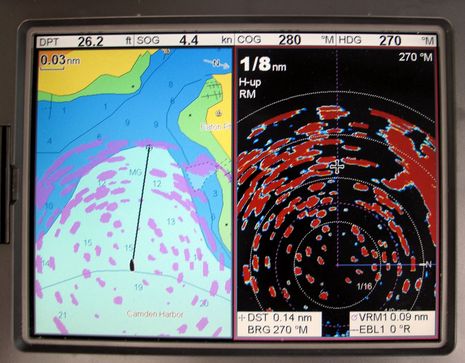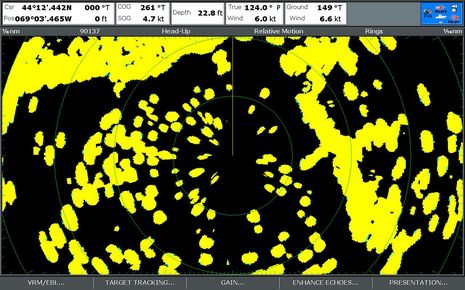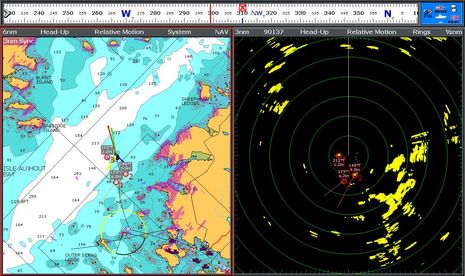18″ radome testing, part 2
Man, this radome testing is getting complicated. I had kinda presumed that the Navico Broadband BR24 would be obviously superior to other 18″ scanners. But, as discussed recently, the Raymarine RD418D kinda torpedoed that presumption. While I doubt that any radar can target a moving dinghy and two sailboats on a float at 100 feet as cleanly as you see above, there is a lot more to radar than super near range. The inflatable, incidentally, dissappeared when it got nearly alongside, but that situation may change when I move the BR dome down to flying bridge level. And then I’ll also have two radar mounts available for testing 18″ scanners from Garmin and Furuno…
Those tests remain to be done, but here’s a look at some comparisons between the Navico and Raymarine domes at 1/8th and 3 mile ranges. This first pair was taken in Camden’s Outer Harbor channel, in nearly the same place recently shown on Bruce Kessler’s 4′ Furuno UHD and on the BR24 when mounted just 5 feet off the water. My photo is unfortunately blurry, but it does show how a higher Broadband can still target those low round channel marker pairs, or at least at about 300′ (1/16 nm = 375′), and how well it separates targets within that 1/8 mile circle. There have been many days this summer when this resolution in this spot would have been very comforting. (Incidentally, the C-Map card in this Simrad NX is two years old; a newer one would indicate the channel better.)
Now below is the RD418D at the same scale and in the same channel. Close in targets are certainly more blown out, and range resolution more uncertain, but this performance level would still be darn useful in thick fog. When you range up from here through the very useful 1/4, 1/2, 1, and 1 1/2 mile scales the performance gets more similar, and then the comparison starts swinging the other way…
Below, for instance, is the BR24 as seen on the Simrad NX45 at 3 nm range. The bold islands 2 miles ahead are painting well, as is the buoy a mile off our starboard quarter. But I believe some closer targets are being lost at this range, plus you can see an intermittent interference spoke as mentioned in the earlier entry, only now I’ve got the radar set for maximum interference rejection.
Comparing that screen to the C140W below is somewhat unfair, as the latter has lots more pixels to work with, and also scales its radar window differently. Those are one mile rings on the Simrad above versus 1/2 mile on the Raymarine below. But you are beginning to see the RD418D’s 4kw power come into play, which gets more emphatic as you range out from here. You can also see MARPA in action, which is not available on either the NX or HDS (though I imagine a BR24 supports it pretty well). Then again, the radar below is using 40 watts versus 17 above. See what I mean about complications? More soon, but I’ve got installation chores first.


















The parameters of the screen shots that you provide are not sufficiently identical to make a comparison. Full-screen radar to full-screen radar at the same scale would be helpful. The two systems appear to render charts differently; further complicating comparisons. Without knowing the surrounding terrain, it is even difficult to correlate the radar images to their own charts. Is everything set to the same range withing each comparison? Perhaps a less cluttered location with identical ranges and scales would be more useful – a place where you could anchor or moor?
Ben-
All very interesting. I wonder about antenna and radome design feature differences between the two radars may account for part of what you are seeing. Microstrip patch antennas are not as efficient as slotted waveguide so the detailed design of the patches and feed network is very important. There may be some concern there – ie the actual beam shape of the two radars may be significantly different despite being the same size. Sidelobes may be higher on a microstrip antenna than waveguide.
The other notion I have is that for each range setting on the screen, I believe that the BR uses a new waveform setting that adjusts the range resolution accordingly. In some cases high range resolution (small range gates) results in LOWER amplitude returns from large distributed targets – such as islands etc (Smaller area illuminated per range gate).
The amplitude of a Radar signal return is the product of the target reflectivity and the range gate size. The lower range resolution (larger range gate) of the pulsed radar may be a benefit in seeing large distributed targets at range – IN CLEAR WEATHER – not power.
What you need is to see if you can make a comparison in light to moderate rain. Then the smaller range gates will see less rain backscatter and the maggie based radar with larger range gates will see more rain – not targets. If the BR24 has 2x better range resolution it should have better performance in Rain.
Its easy to determine the range resolution of the pulse radars per range setting by noting the pulse width used – is there a list of the range resolution values per range setting for the BR 24??
I’m going to guess that they set the resolution to match the screen pixels that are available to some extent. That would allow a constant size Fast Fourier Transform (the math needed to transform linear Frequency modulation to range) such as a 1024 point cFFT. Lets say that you have 640 to 1024 vertical pixels. If you need to display 1/2Nmi then 3040 ft/1024 pixels = 3ft per pixel to 3040/640 ~ 5ft per pixel. But set the range to 3Nmi and the resolution changes to 18ft to 29ft per pixel and so on.
So to make a true comparison the two displays must be the same number of pixels per inch so that the comparison is fair. Otherwise you are seeing “apparent” resolution. A display with twice the vertical pixels on the Raymarine will make the targets look finer for the same range extent than the BR24. You’re compressing range extent down to a smaller physical space on the screen when a display has more pixels.
DaveV, this is very deep stuff! The average user is only interested in WYSIWYG not the difference between slotted array and micro strip antenna’s or even the theory of Fast Fourier calculations. It’s all interesting and I enjoy reading all about it but users only want the best bang for their buck.
Broadband radar has hit the scene in a very big way making all sorts of safety and performance claims. I am yet to read any end user reports from experienced skippers backing these claims. Here Ben has popped the BR radar on his vessel and from what I understand its long range performance is less than average and there are interference issues from pulsed radars? Not good given the claims Navico are making. The digital pulsed radars do not have intereference issues (from other radars), work far better on long ranges and by all accounts the difference in short range detection is not that significant, if at all? Are the users saying that Navico has made a big splash with Broadband which has turned out to be nothing really special?
Threats to my peace of mind are not an hour away, they are in the next thirty seconds, so BR has great appeal to me. I really struggle to understand the highly technical discussions of the BR radar, and, quite frankly, don’t care. My issues begin and end at what I can see on my screen, and whether I can make sense of it. Ben’s approach is the right one from this user’s point of view.
Sandy, the BR24 is truly great in terms of start up speed. It’s just a long pause from dead cold to transmitting, and nearly instant from standby (under 2 watts) to transmit. The Raymarine takes a triple long pause (I should time these) just to get ready, then 70 seconds to get into standby, which they spec at 20 watts (standby to transmit is pretty fast).
Ron, the comparison pairs are set at 1/8nm range and 3nm range as shown on the screens and stated in text. I used the split views with overlay so you could get a better sense of what’s targeted.
Ben: I made a comment earlier this year (I don’t know how to get the search function to find it) on all the features I was looking for in the next generation radar /chartplotter. Most or many were radar functions.
Someone on Panbo made the comment along the lines that it was better than some market research they had.
I wonder if that comment could be found, if some of that could be used to compare the products here ?
This is great stuff Ben…I am just about to get electronics for my 32ft catamaran…..I was very interested in the broadband but am a big fan of Raymarine..your tests are helping me decide which way to go.
At one point I was thinking of Raymarine and Navico on board but from what you are showing I think it will be all Raymarine.
One thing Raymarine has as well that I haven’t seen on anything else is the system diagnostics,which appeals to me as a tech.
cheers Peter
I agree Sandy, likewise I am not that interetsed in 24nm range and further unless looking at storm intensity and rain squalls. BR radar promotes very close range (ie: a few feet) but with a radar installed up on my fly bridge it will not see the exceptionally close range that they are promoting (ie: a few feet). In the 1/4 mile range I have seen pulsed radars (the new UHD Furuno and HD Raymarine) perform on par if not better than the BR at close range. This included channel markers and small vessels. Also if you’re looking at close range targets then you do not want ANY interference, especially spokes from other radars.
Start up time (warm up) is not a consideration for me but merely another sales pitch by the BR developers. Seriously, have you ever needed less than 70sec (that’s little over a minute) to switch on your radar. If I’m navigationg at niht the radar gets started before I leave the dock / mooring and if I can see fog or darkness approaching I turn my radar on well in advance. Power saving is a consideration but with the power save modes, watchman modes and stand by modes offered by the pulsed radar manufacturers I cannot see that swaying me towards BR radar either.
Does the BR radar offer ARPA(Simrad/Lowrance/Northstar)?
Glad to be of help, Peter, but do note that several MFDs now have good diagnostics. The Garmin 4- and 5000 Series come to mind, along with the Lowrance HDS. And both of those are way ahead of Raymarine in terms of being able to see what’s happening on an attached NMEA 2000 network, and make choices about it. I keep hoping that Raymarine will catch up in this dept., but it hasn’t happened so far.
The NavNet3D radar doesn’t seem to be in this discussion for some reason. I have it and think it is excellent. The real feature that is the differentiator is its ability to run at two distance settings at the same time. I agree that it is important to track what is close and to find the buoys on a 1/4 or 1/2 nm setting but it also great to be able to watch for that fast moving ship on a 4 or 8 nm setting at the same time. Last time I looked, the other radars were not doing that yet.
And then I’ll also have two radar mounts available for testing 18″ scanners from Garmin and Furuno…
I look forward to this, and especially seeing how you decide to do a fair comparison.
I don’t know how radar range ratings are done. I suspect that there is no standard, no test, and that this is just a marketing convention. For an 18″ radome, 24 nm really means 2 kW. More power and/or a larger array give more range. But is there a standard target for comparing actual results? And for what tuning settings?
I stand corrected…yes the Garmin 5008 here has diagnostics….harder to find than in the Raymarine menu though.cheers
John-
Deep maybe – but without technical explanations statements made about a topic as complex as marine radar become just conjecture and opinions.
From a “everyday users” perspective, to me finding targets under 6 Nm is most critical. I’ve been stuck in fog banks in the WA San Juan Islands a few times now and looking for both high speed ships and ferrys that are traveling parallel or perpendicular to my required course are of great interest. The other concern I’ve run across is small alum / FRP fishing boats blasting along at 20+ kts in the fog. Incomprehensible to be sure but I have seen this a few times already.
So for my $$$ on our 8-10Kt trawler I need very good resolution at 6 Nmi and less. The height of my radar is only 18ft above the water so the curvature of the earth is going to limit me to far less than 20 Nmi. So despite my 24″ Raymarine’s 4Kw transmit power I’m not likely to see much beyond 10 Nmi most of the time for targets with less than 20ft of vertical extent. 100ft tall ships more than 10 Nmi away are not a threat.
I’ve mentioned before that I consider a combination AIS Receive and my radar to be most critical to my safety. AIS is to alert me to large ships to predict their movement that may intersect my course. Radar is needed to be sure I see the little fishing boats and other yachtsmen not carrying a transmitting AIS.
To me – getting good performance in RAIN would seem to be an important discriminator that has not been tested yet in Ben’s comparisons. I hope he gets the chance as that may be the venue to show the value of the BR capabilities.
WRT pulse radar interference with the BR – I don’t consider that a big deal. It does not appear to be visually severe. I’ve seen my 24″ Raymarine generate tons of sidelobe targets (Multiple copies of a target in a constant range arc) when observing WA State Ferrys or large ocean going tugs etc.
The large number of sidelobe targets can wipe out lots of real targets in the image. So much for the perfection of conventional Magnetron radars. Yes things can be tuned – but when you are in the fog and doing your best to look for logs / debris, verify closing vessels etc I don’t have time to futz with my radar settings. I’ll be head down and not keeping watch.
What is not mentioned here is the need to move to solid state transmitters in the near future for Marine radar, due to pressure from the Int. Telecommunications Union requirements to eliminate “Out of Band emissions” – maggies blast stuff over a wide bandwidth that can interefere with WiFi and other equipment, while Solid State Radars would not.
Lastly – radio frequency radiation hazard is still an issue – the BR system is far safer under all conditions. I won’t add all the “deep” details of why these things are true.
DaveV, You’re right; I haven’t tried these radomes in rain yet, but hope to soon. Thanks for all your comments, by the way!